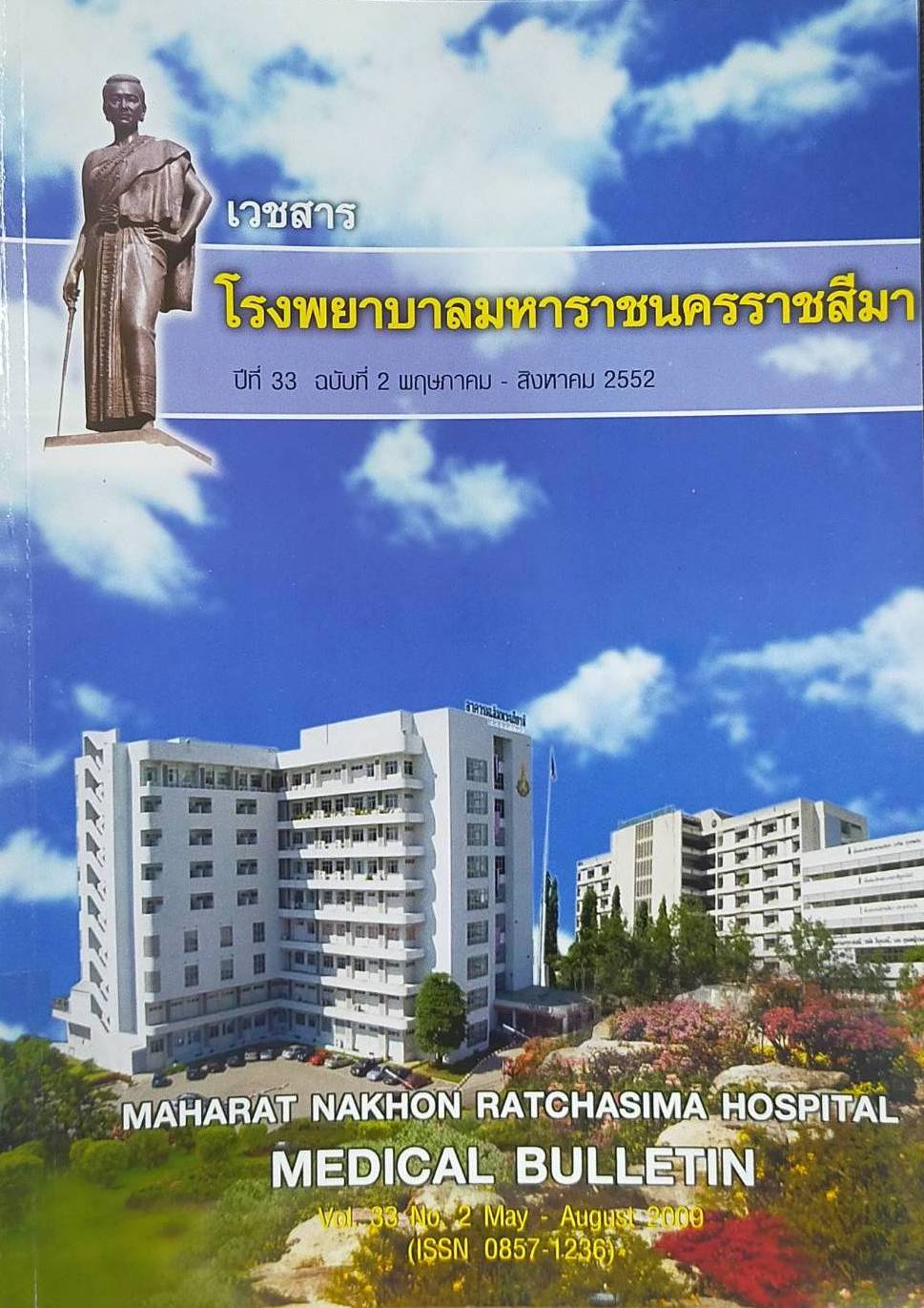Transient Elastography for Evaluating Hepatic Fibrosis in Patients Receiving Methotrexate
Main Article Content
Abstract
Methotexate (MTX) is the drug commonly used in rheumatologic and dermatologic diseases for a long period but it has hepatotoxicity; i.e.hepatic fibrosis. Transient elastography using Fibroscan is easy, non invasive and painless. Aim: To evaluate hepatic fibrosis in patients receiving MTX by Fibroscan. Patients & Method: Transient elastography were performed in patients receiving MTX during November 2008. These patients were treated in Medical Department of Maharat Nakhon Ratchasima Hospital. Fibroscan® 502 from France with M single 3.5 MHz ultrasound probe was used to evaluate hepatic fibrosis by well trained doctors and the result is delivered at the end of the 10 acquisitions as transient elastography with record in median score (kilopascal; kPa), interquartile ratio (IQR). The results were compared with that of the normal liver stiffness 5.5+1.6 kPa. Results: Fifteen patients receiving MTX were recruited. The majority of them were female 12 patients (80.0%) and mean age 55+14 years (age range 28-71 years). Their basic diseases that needed MTX therapy were rheumatoid arthritis 80%. Their MTX data were; last dose of MTX 10.0+1.6 mg/wk (range 7.5-12.5 mg/wk), duration of MTX therapy 51.3+27.6 months (range 15-96 months) and total cumulative of MTX therapy 2.0+1.0 g (range 0.64-3.44 g). Conclusion: MTX receiving patients in Maharat Nakhon Ratchasima Hospital had normal transient elastoghaphy by Fibroscan
Article Details

This work is licensed under a Creative Commons Attribution-NonCommercial-NoDerivatives 4.0 International License.
References
Sandrin L, Fourquet B, Hasquenoph JM, Yon S, Fournier C, Mal F, et al. Transient elastography: a new noninvasive method for assessment of hepatic fibrosis. Ultrasound Med
Biol 2003; 29: 1705-13.
Foucher J, Chanteloup E, Vergniol J, Castra L, Le Bail B, Adhoute X, et al. Diagnosis of cirrhosis by transient elastography (FibroScan): a prospective study. Gut 2006; 55: 403-8.
Stebbing J, Farouk L, Panos G, Anderson M, Jiao LR, Mandalia S, et al. Meta-analysis of Transient Elastography for the Detection of Hepatic Fibrosis. J Clin Gastroenterol 2009; 9.
Curry MP, Afdhal NH. Noninvasive assessment of hepatic fibrosis. UpTodate 17.2; 2009.
Cannella AC, O’Dell JR. Methotrexate, Leflunomide, Sulfas alazine, Hydroxychloroquine, and combination therapies. In: Firestein GS, Budd RC, Harris ED Jr, McInnes IB, Ruddy S, Sergent JS, editors. Kelley’s Textbook of Rheumatology. 8th ed. Philadelphia: Saunders; 2009. p.88-907.
Castera L, Forns X, Alberti A. Non-invasive evaluation of liver fibrosis using transient elasto graphy. J Hepatol 2008; 48: 835-47.
Erickson AR, Reddy V, Vogelgesang SA, West SG. Usefulness of the American College of Rheumatology recommendations for liver biopsy in methotrexate-treated rheumatoid arthritis patients. Arthritis Rheum 1995; 38: 1115-9.
Yazici Y, Erkan D, Tai K, Paget SA. Monitoring for methotrexate hepatic toxicity in RA patients: Is it time to update the guidelines? [abstract]. Ann Rheum Dis 2000; 7: 154.
Kremer JM, Alarcon GS, Lightfoot RW Jr, et al. Methotrexate for rheumatoid arthritis: Suggested guidelines for monitoring liver toxicity. Arthritis Rheum 1994; 37: 316-28.
อัจฉรา กุลวิสุทธ.ิ์ Disease modifying antirheumatic drugs for rheumatoid arthritis. ใน: สุรศักดิ์ นิลกานุวงศ์, สุรวุฒิ ปรีชานนท์, บรรณาธิการ. พิมพ์ครั้งที่ 2. กรุงเทพฯ: เอส พี เอ็น การพิมพ์; 2548. p.1194-234.


